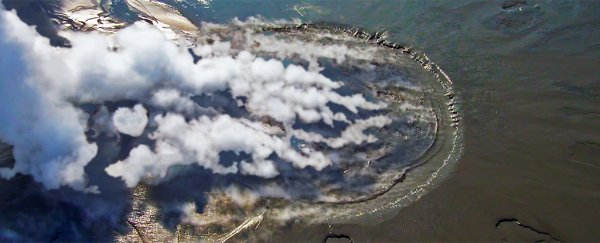The Lusi eruption has been steadily spewing out mud across the Indonesian Island of Java since May 2006 – and scientists think they've finally worked out what's behind it.
New research mapping the ground underneath Lusi has showed it's connected to magma chambers linked to a nearby volcanic system, baking the sediments under the eruption site and continuing to spurt mud, water, and rocks out into the air.
Not only does it give us an answer to why Lusi has become the biggest mud eruption in recorded history, the research could also tell us more about how volcanoes evolve, says the international team of geoscientists.
"We clearly show the evidence that the two systems are connected at depth," says one of the researchers, Adriano Mazzini from the University of Oslo in Norway.
"What our new study shows is that the whole system was already existing there – everything was charged and ready to be triggered."
 Credit: Adriano Mazzini/The Lusi Lab Project
Credit: Adriano Mazzini/The Lusi Lab Project
Previous research had found gases linked to magma in the Lusi eruptions, but before now no one had definitely proved a link to the Arjuno-Welirang volcanic complex.
Using seismometers to create a 3D map of the ground below Java, the team found a tunnel and a series of vents up to 6 kilometres (3.7 miles) underground, connecting a magma chamber in Arjuno-Welirang to the sedimentary basin directly underneath Lusi.
That's enough to pump scorching magma and other hydrothermal fluids into the Lusi site, triggering explosive reactions caused by a high-pressure build-up of gas.
"It's just a matter of reactivating or opening these faults and whatever overpressure you have gathered in the subsurface will inevitably want to escape and come to the surface, and you have a manifestation on the surface, and that is Lusi," says Mazzini.
 A village buried by mud. Credit: Adriano Mazzini/The Lusi Lab Project
A village buried by mud. Credit: Adriano Mazzini/The Lusi Lab Project
And what an eruption. At its peak in September 2006, Lusi was churning out enough mud to fill 72 Olympic-sized swimming pools every single day – up to 180,000 cubic metres (6.4 million cubic feet).
Much of the mud has now hardened, but the eruption has covered an area twice the size of New York's Central Park, with nearly 60,000 Indonesians forced out of their homes to escape the tides of mud reaching as high as 40 metres (131 feet).
Even in 2017 the site continues to cough up enough mud and other material to fill 32 Olympic-sized swimming pools every day, still nearly half of its peak output.
As well as explaining continued activity at Lusi, the discovery could shed light on how other volcanic systems evolve underground, and even shift their location as underground pressures build up and get released.
Unfortunately for the people of Java, it's unlikely that the flow of mud is going to stop anytime soon: the volcanic chambers are going to keep the site cooking for several years to come.
"So what it means to me is that Lusi's not going to stop anytime soon," says Stephen Miller, from the University of Neuchâtel in Switzerland, who wasn't involved in the study.
The research has been published in the Journal of Geophysical Research: Solid Earth.
The American Geophysical Union has produced a video on the research which you can see below:

